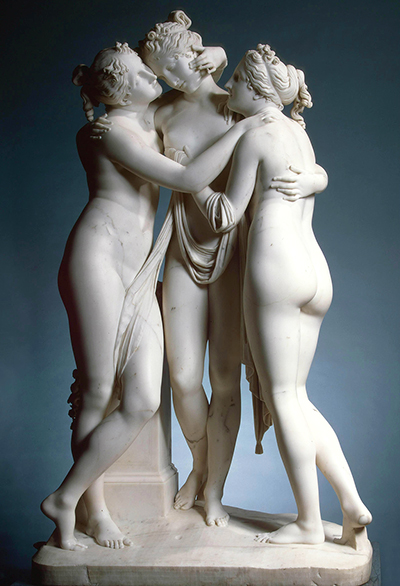This sculpture was made from carved marble for an art gallery in Woburn Abbey, Bedfordshire. It was commissioned by the 6th Duke of Bedford, John Russell. The sculpture was initially placed in a specially developed Temple of the Graces.
The sculptor, Antonio Canova born in 1757 and died in 1822, was visited by John Russell in his studio in Rome in the year 1814. The Duke of Bedford was impressed by the Three Graces that Antonio had sculpted for Empress Josephine, a wife to Napoleon Bonaparte. John Russell was captivated and commissioned another version of the Three Graces from Antonio Canova which he started carving in the year 1814 and completed in 1817 before being installed at Sculpture Gallery in Woburn in 1819. The Three Graces, depicted in classical artworks and literary works, were daughters to Jupiter, popularly known as Zeus in Greek, and were also companions to the Muses. Antonio had previously depicted the Three Graces in a painting he did in the year 1799.
Dedicated to the Neoclassical ideal, Antonio Canova depicted the perceptions he had regarding the beauty of the Three Graces in the form of goddesses who are rumoured to have personified feminine characteristics. Modern artists have hailed the sculpture for its unique approach to the subject. Antonio Canova depicts the figures standing close to each other while facing one another. The three slim feminine figures are conjoined and become one in their embrace, joined together not just by their conjoined hands, but as well by the scarf that falls from the hand of one of them.
Antonio Canova's carved marble is much based on his previous paintings of the subject, as well as a closely similar terracotta sketch model. The type of carved Marple utilized by Antonio Canova in his work, the Three Graces was the full-size plaster model, which up to now is available in the Canova Museum located at Possagno in the Italian nation. This contains points on it that were utilized to move the components from the plaster onto the carved Marple.
The sculptor himself created the original design; however, his counterparts would roughly carve out the Marple. He would then make the final touches and complete the final sculpture. He made sure that the surface of the Marple stone was completed in such a manner that depicted the tender flesh of the objects and the harmonious connection between the three heads of the Three Graces, for instance.




